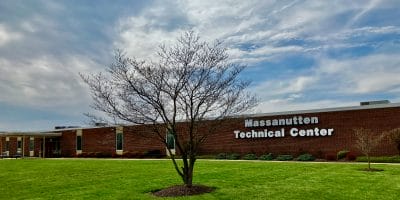
Article and photos by Randi B. Hagi, assistant editor
As she drives along a dirt-and-gravel road between Reddish Knob and Flagpole Knob, Lynn Cameron points out particular stands of trees and pockets of brush like a city dweller might point out their favorite coffee shop or a friend’s house they used to visit.
“There is a wildflower right here that’s very rare, that I just wanted to check on and see if it’s out yet … oh, oh! It’s out,” she says, stopping the car.
A wildflower vine had been growing on a specific tree that the U.S. Forest Service took down during road maintenance. By the end of April, the vine had reestablished itself on nearby shrubs and was starting to bloom.
“I found this one. I’m so proud of that,” Cameron says, smiling. Her intimate familiarity with these woods is borne out of her 31-year effort to protect them. She’s a cofounder of the Friends of Shenandoah Mountain, a grassroots group that’s trying to establish the Shenandoah Mountain National Scenic Area – 90,000 acres of land in the George Washington National Forest stretching from Route 33 in the north to Route 250 in the south.

Now, the proposed scenic area could be one step closer to becoming reality, as members of the Highland County Board of Supervisors are expected to vote on a resolution of support at their meeting tonight. The other four affected jurisdictions – Augusta County, Staunton, Rockingham County, and Harrisonburg, have already signed off.
While the U.S. Congress must approve any such designations on federal land, local government support is necessary.
National Scenic Areas are swaths of land that have even more protections than a national forest. Hiking, mountain biking, hunting and fishing are still permitted, but timber sales, fracking and other commercial uses are not. And within this proposed scenic area would be four pockets of proposed Wilderness Areas, in which no vehicles, even bikes, would be allowed.
Shenandoah Mountain and its watershed are especially precious, Cameron said, because of the area’s incredible levels of biodiversity – including species endemic to the region, such as the cow knob salamander.
“As time goes by, these areas are disappearing little by little,” she said.

Cameron’s ecological advocacy was sparked in the mid-1980s, when she and her husband Malcolm began exploring local public lands and made friends with folks on the Virginia Wilderness Committee.
“We hiked in the Shenandoah National Park, and hiked pretty much all the trails there. And then we started moving to the west and exploring the national forest and especially the Shenandoah Mountain area with our Potomac Appalachian Trail Club … in about the mid-’80s. And this area over here just seemed so much wilder,” Cameron said. “It was big and wild over here, and we just fell in love with this area.”
To get the proposal this far, Cameron has had to work with different types of forest enthusiasts, such as mountain bikers, bear hunters and biologists. She and the other wilderness proponents have had to compromise with the mountain bike faction of Friends of Shenandoah Mountain.

One point of contention was the proposed Little River Wilderness area between Stokesville and Reddish Knob. Cyclists won’t be able to ride the trails in there if the proposal makes it through Congress.
“They had to give up a couple trails, and that was painful for them,” Cameron said. “And we opened up a trail along Ramsey’s Draft Wilderness. That was painful for people who didn’t really want to do that. Compromise is painful, but when you look back at it, you think, where would we be if we hadn’t done this? We would be nowhere.”
After cultivating community buy-in, Cameron and her fellow enthusiasts set to work on local governments. Augusta County was the first to pledge support to the effort in June 2019, on a 6-1 vote. Staunton and Rockingham County followed with unanimous votes. Harrisonburg’s city council unanimously approved its resolution on March 23 in part because of efforts by new council member Laura Dent.

Dent heard some concerns from people in city government that the move could limit the city’s ability to tap into additional water supplies on that land in the future.
To assuage those fears, Dent added a clause to the resolution that, while these lands would be protected from commercial leases and the federal government, the city could still access the land if needed.

If Highland County follows suit tonight, the Friends’ next step will be to meet again with representatives of the timber industry, game managers and hunting organizations that make up the George Washington National Forest Stakeholder Collaborative. They first signed an agreement endorsing the scenic area about 10 years ago.
The longevity of this struggle presents certain challenges. There’s turnover within every allied group: the stakeholders, the forest service staff, leaders within the mountain biking community. Cameron said she hopes the old treaties will hold. Years ago, her group adjusted the boundaries of the original proposal by 25,000 acres to appease the national forest stakeholders.
“I’m hoping they will realize that’s a gift that keeps giving … and they’ll be supportive,” she said.

When it’s time for the final push in Congress, U.S. Sen. Tim Kaine has already agreed to champion the scenic area.
But Cameron said the group has yet to garner support from U.S. Rep. Ben Cline, who represents the 6th Congressional District where the scenic area would be.
“This seems like a worthy thing to do if you love and have an appreciation for special places,” said Cameron. “You can actually get together with other people and work to try to protect them, permanently.”

Journalism is changing, and that’s why The Citizen is here. We’re independent. We’re local. We pay our contributors, and the money you give goes directly to the reporting. No overhead. No printing costs. Just facts, stories and context. We’re also a proud member of the Virginia Press Association. Thanks for your support.













